 W
WThe Battle of Arbroath was fought on 24 January 1445 at Arbroath in Scotland. It was between rivals claimants to the post of Baillie of the Regality.
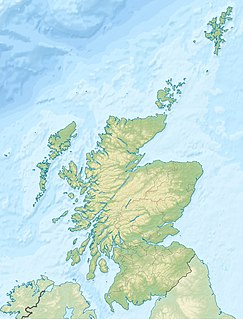 W
WThe Battle of Auldearn was an engagement of the Wars of the Three Kingdoms. It took place on 9 May 1645, in and around the village of Auldearn in Nairnshire. It resulted in a victory for the royalists, led by the Marquess of Montrose and Alasdair MacColla, over Sir John Urry and an army raised by the Covenanter-dominated Scottish government.
 W
WBattle of Bauds was a battle fought in 962 in an area known as the Bauds, south of Findochty and west of Cullen near Portknockie, Scotland between Scotland under King Indulf, and Norse pirates. The Vikings had been raiding and burning through Scotland, and had won numerous skirmishes against the Scots, including the Battle of Dollar. However, in this battle, the Norsemen were defeated. Afterwards, Norse control in Scotland fell apart. However, Indulf was killed in the battle.
 W
WThe Battle of Baugé, fought between the English and a Franco-Scots army on 22 March 1421 at Baugé, France, east of Angers, was a major defeat for the English in the Hundred Years' War. The English army was led by the king's brother Thomas, Duke of Clarence, while the Franco-Scots were led by both John Stewart, Earl of Buchan, and Gilbert Motier de La Fayette, the Marshal of France. English strength was 4,000 men, although only 1,500 deployed, against 5,000 French and Scots.
 W
WThe Battle of Benburb took place on 5 June 1646 during the Irish Confederate Wars, the Irish theatre of the Wars of the Three Kingdoms. It was fought between the Irish Confederation under Owen Roe O'Neill and a Scottish Covenanter and Anglo-Irish army under Robert Monro. The battle ended in a decisive victory for the Irish Confederates and ended Scottish hopes of conquering Ireland and imposing their own religious settlement there.
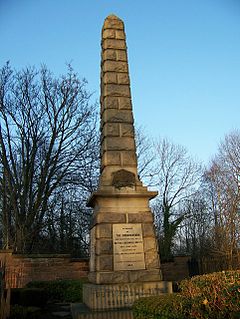 W
WThe Battle of Bothwell Bridge, or Bothwell Brig, took place on 22 June 1679. It was fought between government troops and militant Presbyterian Covenanters, and signalled the end of their brief rebellion. The battle took place at the bridge over the River Clyde between Hamilton and Bothwell in Lanarkshire, Scotland. The battlefield has been included in the Inventory of Historic Battlefields in Scotland and protected by Historic Scotland under the Historic Environment (Amendment) Act 2011.
 W
WThe Battle of Brunanburh was fought in 937 between Æthelstan, King of England, and an alliance of Olaf Guthfrithson, King of Dublin; Constantine II, King of Scotland, and Owain, King of Strathclyde. The battle is often cited as the point of origin for English nationalism: historians such as Michael Livingston argue that "the men who fought and died on that field forged a political map of the future that remains [in modernity], arguably making the Battle of Brunanburh one of the most significant battles in the long history not just of England, but of the whole of the British Isles."
 W
WThe Chaseabout Raid was a rebellion by James Stewart, 1st Earl of Moray, against his half sister, Mary, Queen of Scots, on 26 August 1565, over her marriage to Henry Stuart, Lord Darnley. The rebels also claimed to be acting over other causes including bad governance, and religion in the name of the Scottish Reformation. As the government and rebel forces moved back and forth across Scotland without fighting, the conflict became known as the "chase about raid." Queen Mary's forces were superior and the rebel lords fled to England where Queen Elizabeth censured the leader.
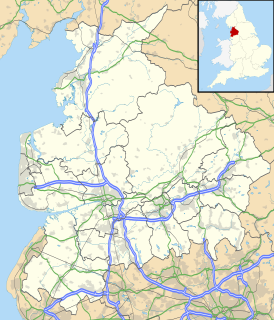 W
WThe Battle of Clitheroe was a battle between a force of Scots and English knights and men at arms which took place on 10 June 1138 during the period of The Anarchy. The battle was fought on the southern edge of the Bowland Fells, at Clitheroe, Lancashire.
 W
WThe Battle of Cravant was fought on 31 July 1423, during the Hundred Years' War between English and French forces at the village of Cravant in Burgundy, at a bridge and ford on the banks of the river Yonne, a left-bank tributary of the Seine, southeast of Auxerre. The battle ended in a victory for the English and their Burgundian allies.
 W
WThe Battle of Cromdale took place at the Haughs of Cromdale on 30 April and 1 May 1690. The site is on a hillside near the village of Cromdale, then in Inverness-shire and now in the Highland council area. The battlefield has been included in the Inventory of Historic Battlefields in Scotland and protected by Historic Scotland under the Scottish Historical Environment Policy of 2009.
 W
WThe Battle of Culblean was fought on 30 November 1335, during the Second War of Scottish Independence. It was a victory for the Scots led by the Guardian, Sir Andrew Murray over an Anglo-Scots force commanded by David III Strathbogie, titular Earl of Atholl, and a leading supporter of Edward Balliol.
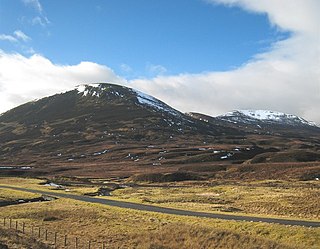 W
WThe Battle of Dalnaspidal occurred on 19 July 1654 during the Wars of the Three Kingdoms. It was one of the last engagements in the war bringing an end to the Royalist rising of 1653 to 1654.
 W
WThe Battle of Dollar was an 875 battle fought in Dollar, Scotland between Danish invaders under Thorstein and the men of Alba under Constantine I. The Danes defeated the men of Alba and then occupied Caithness, Sutherlandshire, Ross, and Moray, far to the north of the battle site.
 W
WThe Battle of Drumclog was fought on 1 June 1679, between a group of Covenanters and the forces of John Graham of Claverhouse, at Drumclog, in South Lanarkshire, Scotland.
 W
WThe Siege of Dumbarton was a successful four-month siege of the Brittonic fortress at Dumbarton Rock in 870, initiated by the Viking leaders Amlaíb, King of Dublin, and Ímar. Dumbarton was capital of the Kingdom of Alt Clut, the only surviving Brittonic kingdom outside of Wales. It represented a valuable target for the Viking invaders, who were likely motivated by strategic considerations, as well as loot. The attackers may have wished to remove Alt Clut as a maritime power, and the location and defensiveness of Dumbarton itself was of major value.
 W
WThe Battle of Dunbar was fought between the English New Model Army, under Oliver Cromwell, and a Scottish army commanded by David Leslie, on 3 September 1650 near Dunbar, Scotland, and was decisively won by the English. It was the first major battle of the 1650 invasion of Scotland, which was triggered by Scotland's acceptance of Charles II as king of Britain after the beheading of his father, Charles I on 30 January 1649.
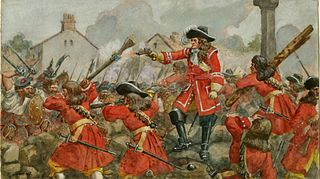 W
WThe Battle of Dunkeld was fought between Jacobite clans supporting the deposed king James VII of Scotland and a regiment of covenanters supporting William of Orange, King of Scotland, in the streets around Dunkeld Cathedral, Dunkeld, Scotland, on 21 August 1689 and formed part of the Jacobite rising of 1689, commonly called Dundee's rising in Scotland. The battlefield was added to the Inventory of Historic Battlefields in Scotland in 2012.
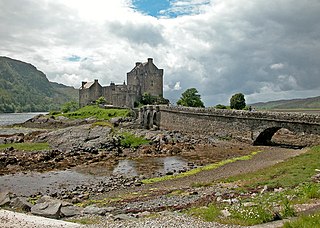 W
WThe Capture of Eilean Donan Castle was an land-based naval engagement that took place in 1719 during the British Jacobite rising of that year, and the War of the Quadruple Alliance. A British naval reconnaissance force of three ships attacked the castle of Eilean Donan on the west coast of Scotland, which was held by Spanish troops. After a naval bombardment, the British government forces stormed the castle, and the defenders surrendered. The castle was subsequently destroyed with gunpowder.
 W
WThe Battle of Frankfurt an der Oder on 13 April 1631 was a battle of the Thirty Years' War. It was fought between the Swedish Empire and the Holy Roman Empire for the strategically important, fortified Oder crossing Frankfurt an der Oder, Brandenburg, Germany.
 W
WThe Battle of Glasgow was fought on 16 March 1544, between Matthew Stewart, 4th Earl of Lennox and the Scottish Regent James Hamilton, 2nd Earl of Arran, and their adherents, during the minority of Mary, Queen of Scots. There was a second battle at Glasgow Muir in May 1544 between Arran and the Earl of Glencairn.
 W
WThe Battle of Glen Shiel, or Scottish Gaelic: Blàr Ghleann Seile, took place on 10 June 1719 in the West Scottish Highlands, during the 1719 Jacobite Rising. A Jacobite army composed of Highland levies and Spanish marines, was defeated by British troops, reinforced by a Highland Independent Company.
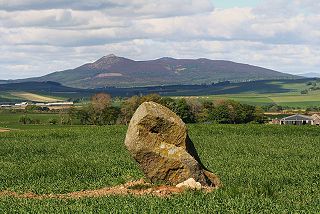 W
WThe Battle of Harlaw was a Scottish clan battle fought on 24 July 1411 just north of Inverurie in Aberdeenshire. It was one of a series of battles fought during the Middle Ages between the barons of northeast Scotland against those from the west coast.
 W
WThe Battle of Heavenfield was fought in 633 or 634 between a Northumbrian army under Oswald of Bernicia and a Welsh army under Cadwallon ap Cadfan of Gwynedd. The battle resulted in a decisive Northumbrian victory. The Annales Cambriae record the battle as Bellum Cantscaul in 631. Bede referred to it as the Battle of Deniseburna near Hefenfelth.
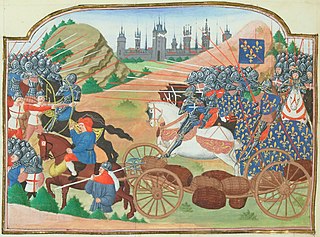 W
WThe Battle of the Herrings, also called the Battle of Rouvray, was a military action near the town of Rouvray in France, just north of Orléans, which took place on 12 February 1429 during the siege of Orléans in the Hundred Years' War. The immediate cause of the battle was an attempt by French and Scottish forces, led by Charles of Bourbon and Sir John Stewart of Darnley, to intercept a supply convoy headed for the English army at Orléans. The English had been laying siege to the city since the previous October. This supply convoy was escorted by an English force under Sir John Fastolf and had been outfitted in Paris, whence it had departed some time earlier. The battle was decisively won by the English.
 W
WThe Battle of Hieton was a skirmish fought on the 1 December 1650 between a Covenanter party and an English garrison. The site of the battle was by the Cadzow Burn, near the present day town centre of Hamilton, Scotland.
 W
WThe Battle of Inverkeithing was fought on 20 July 1651 between an English army under John Lambert and a Scottish army led by James Holborne. It was a part of the English Invasion of Scotland during the Third English Civil War. The battle was fought near the isthmus of the Ferry Peninsula, to the south of Inverkeithing, after which it is named.
 W
WThe Battle of Inverlochy (1431) was fought after Alexander of Islay, Lord of the Isles and Earl of Ross, had been imprisoned by King James I. A force of Highlanders led by Donald Balloch, Alexander's cousin, defeated Royalist forces led by the Earls of Mar and Caithness at Inverlochy, near present-day Fort William. Over 1000 men were supposedly killed, among them the Earl of Caithness. Balloch then went on to ravage the country of Clan Cameron and Clan Chattan, who had been loyal to the king during the rebellion. King James himself soon after led an army into the Highlands, and the rebel forces disintegrated.
 W
WThe Battle of Killiecrankie, also referred to as the Battle of Rinrory, took place on 27 July 1689 during the 1689 Scottish Jacobite rising. A Jacobite force under John Graham, Viscount Dundee defeated a government army commanded by Hugh Mackay.
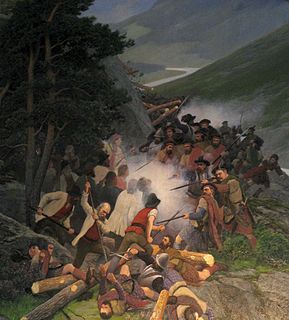 W
WThe Battle of Kringen involved an ambush by Norwegian peasant militia of Scottish mercenary soldiers who were on their way to enlist in the Swedish army for the Kalmar War.
 W
WThe Battle of Landen or Neerwinden took place on 29 July 1693, during the Nine Years' War. It was fought around the village of Neerwinden in the Spanish Netherlands, now part of the municipality of Landen, Belgium.
 W
WThe Battle of Langside was fought on 13 May 1568 between forces loyal to Mary, Queen of Scots, and forces acting in the name of her infant son James VI. Mary’s short period of personal rule ended in 1567 in recrimination, intrigue, and disaster when, after her capture at Carberry Hill, she was forced to abdicate in favour of James VI, her infant son. Mary was imprisoned in Loch Leven Castle, while her Protestant half-brother, James Stewart, Earl of Moray, was appointed Regent on behalf of his nephew. In early May 1568 Mary escaped, heading west to the country of the Hamiltons, high among her remaining supporters, and the safety of Dumbarton Castle with the determination to restore her rights as queen. Mary was defeated and went into exile and captivity in England. The battle can be regarded as the start of the Marian civil war.
 W
WThe Battle of Largs was a decisive, albeit small, battle between the kingdoms of Norway and Scotland, on the Firth of Clyde near Largs, Scotland. Like the Japanese victories over the Mongol Invasions at roughly the same time or the much later Battle of Coral Sea, Scotland achieved the end of 500 years of Norse Viking depredations and invasions despite being tremendously outnumbered, without a one-sided military victory in the ensuing battle. That said, the victory caused the complete retreat of Norwegian forces from western Scotland and the realm entered a period of prosperity for almost 40 years. The tactical decision at Largs thus led to a sweeping strategic victory that ended in Scotland purchasing the Hebrides Islands and the Isle of Mann in the Treaty of Perth, 1266. Victory was achieved with a crafty three-tiered strategy on the part of the young Scottish king, Alexander III: plodding diplomacy forced the campaign to bad weather months and a ferocious storm ravaged the Norwegian fleet, stripping it of many vessels and supplies and making the forces on the Scottish coast vulnerable to an attack that forced the Norwegians into a hasty retreat that was to end their 500-year history of invasion and leave Scotland to consolidate its resources into building the nation. The conflict formed part of the Norwegian expedition against Scotland in 1263, in which Haakon Haakonsson, King of Norway attempted to reassert Norwegian sovereignty over the western seaboard of Scotland.
 W
WThe Battle of Leuze was a minor Cavalry engagement of the Nine Years' War that took place on 18 September 1691 between a detachment of French and a superior Allied force.
 W
WThe Battle of Lumphanan was fought on 15 August 1057, between Macbeth, King of Scots, and Máel Coluim mac Donnchada, the future King Malcolm III. Macbeth was killed, having drawn his retreating forces north to make a last stand. According to tradition, the battle took place near the Peel of Lumphanan in Aberdeenshire. Macbeth's Stone, some 300 metres (980 ft) south-west of the peel, is said to be the stone upon which Macbeth was beheaded.
 W
WThe Battle of Mauchline Muir was an engagement fought on 12 June 1648 between two rival factions of the Covenanters of Scotland. On one side where those who favoured The Engagement, known as Engagers, and those who were opposed to the Engagement, and known as the Kirk party.
 W
WThe Battle of Mulroy was a Scottish clan battle fought in August 1688 in the Lochaber district of Scotland. It was fought between the Clan Mackintosh who were supported by government troops under Kenneth Mackenzie of Suddie against the Clan MacDonald of Keppoch who were supported by the Clan Cameron over disputed lands in the Braes of Lochaber. The battlefield has been inventoried and protected by Historic Scotland under the Scottish Historical Environment Policy of 2009.
 W
WThe Battle of Newburn, also known as Battle of Newburn Ford, took place on 28 August 1640, during the Second Bishops' War. It was fought at Newburn, a village just outside Newcastle, situated at a ford over the River Tyne.
 W
WThe Battle of Preston, fought largely at Walton-le-Dale near Preston in Lancashire, resulted in a victory for the New Model Army under the command of Oliver Cromwell over the Royalists and Scots commanded by the Duke of Hamilton. The Parliamentarian victory presaged the end of the Second English Civil War.
 W
WThe Battle of Ronaldsway took place in 1275 at Ronaldsway in the southern part of the Isle of Man between a Scottish army and the Manx. The battle crushed the final attempt by the Manx to re-establish the Norse Sudreyar dynasty. As the battle resulted in the death of the last Norse King of Mann, Guðrøðr Magnússon, and the emigration to Norway of the remaining members of the Manx royal family, it also led to the firm establishment of Scottish rule on the Isle of Man.
 W
WThe Battle of Rullion Green took place on 28 November 1666, near the Pentland Hills, in Midlothian, Scotland. It was the only significant battle of the Pentland Rising, a brief revolt by Covenanter dissidents against the Scottish government.
 W
WThe Battle of Steenkerque was fought on 3 August 1692, as a part of the Nine Years' War. It resulted in the victory of the French under Marshal François-Henri de Montmorency, duc de Luxembourg against a joint English-Scottish-Dutch-German army under Prince William of Orange. The battle took place near the village of Steenkerque in the Southern Netherlands, 50 kilometres (31 mi) south-west of Brussels. Steenkerque is now part of the Belgian municipality of Braine-le-Comte.
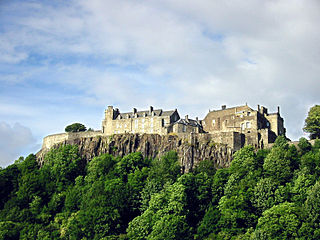 W
WThe second Battle of Stirling was fought on 12 September 1648 during the Scottish Civil War of the 17th century. The battle was fought between the Engagers who were a faction of the Scottish Covenanters under the command of George Munro, 1st of Newmore and who had made "The Engagement" with Charles I of England in December 1647, against the Kirk Party who were a radical Presbyterian faction of the Scottish Covenanters who were under the command of Archibald Campbell, 1st Marquess of Argyll.
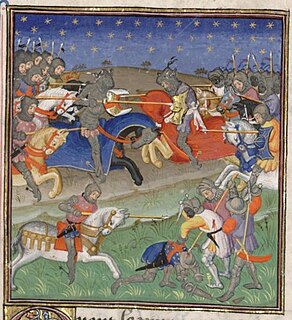 W
WThe Battle of Teba took place in August 1330, in the valley below the fortress of Teba, now a town in the province of Málaga in Andalusia, southern Spain. The encounter occurred during the frontier campaign waged between 1327 and 1333 by Alfonso XI of Castile against Muhammed IV, Sultan of Granada.
 W
WThe Battle of Verneuil was a battle of the Hundred Years' War, fought on 17 August 1424 near Verneuil in Normandy. The battle was a significant English victory. It was a particularly bloody battle, described by the English as a second Agincourt.
 W
WThe Battle of Walcourt was fought on 25 August 1689 during the Nine Years' War. The action took place near the ancient walled town of Walcourt near Charleroi in the Spanish Netherlands, and brought to a close a summer of uneventful marching, manoeuvring, and foraging. The battle was a success for the Grand Alliance – the only significant engagement in the theatre during the campaign of 1689.